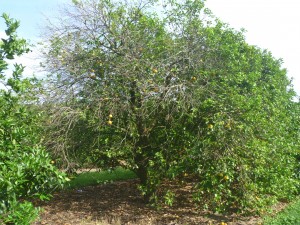
According to the Fresno Bee, more psyllids than could be counted were discovered on three young citrus trees in the back yard of an eastern Dinuba home, the most ever seen in the Valley. Fortunately, none of the bugs were infected with huanglongbing disease, or HLB. Treatment has begun on all citrus plants within 800 meters surrounding the site where the insects were trapped.
Over the last two years, none of the psyllids found in the San Joaquin Valley have been infected with HLB. In January 2012, the first psyllid was found in Strathmore, then two more in November. This July, six more psyllids in were found in Porterville, prompting quarantines in both areas.
With all the publicity, it’s hard to remember that it’s not the insect that kills the trees, only those that are carrying HLB.
This begs the question: why don’t the insects found in California have it?
Only one tree in California has tested positive for HLB. That citrus tree was in the Hacienda Heights neighborhood of Los Angeles and was promptly removed and destroyed.
The Asian citrus psyllid was first detected at a residence in Southern California in August 2008. The industry spent millions of dollars to keep the psyllid from jumping to the Valley from Southern California. Those efforts, up until now, have been successful. But finding multiple bugs means that there is a reproducing population of adults that can easily infest other trees. Once that happens, the San Joaquin Valley will have an established population, if it doesn’t already.
Surveys have also found infestations in areas of San Diego and Imperial counties. Nationally, the psyllid is also found in Florida, Louisiana, Georgia, South Carolina, Texas and Hawaii.
Citrus Greening has no cure, and since 2005 has devastated Florida’s citrus industry. About 50% of their citrus acres have been destroyed because of the disease. According to the New York Times, to slow the spread of HLB, Florida chopped down hundreds of thousands of infected trees and sprayed an array of pesticides to kill the psyllid – but the state could not contain HLB.
It is estimated that nearly 100 million trees in 40 countries are affected by this disease, especially in countries like India, China, Indonesia and the Philippines, as well as in the Arabian Peninsula and Africa. More recently, HLB has been found in Brazil and the United States.
Florida growers sent search parties around the world to find a naturally immune tree that could serve as a new progenitor, but no evidence of immunity was found to exist. This may be true of citrus trees, but it was hypothesized that it could not be true in all of nature.
As stated in the New York Times, “With a precipitous decline in Florida’s harvest predicted within the decade the only chance left to save the trees was one that the industry and others had long avoided for fear of consumer rejection. They would have to alter the orange’s DNA with a gene from another species.” The goal is to genetically engineer resistance to HLB for which standard treatments have proven elusive. This “transgenic” tree could take a decade and $20 million to develop and test for safety.
There is an emerging scientific consensus held that genetic engineering would be required to defeat citrus greening. One University of Florida scientist put it this way, “People are either going to drink transgenic orange juice or they’re going to drink apple juice.”
